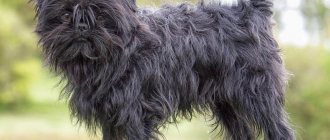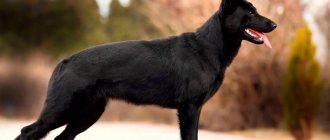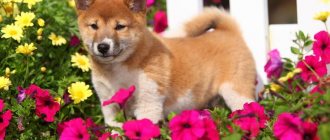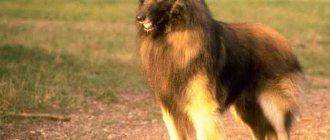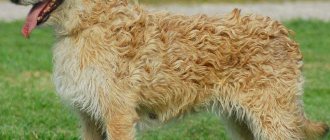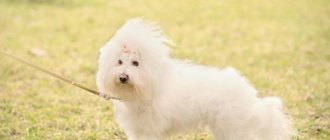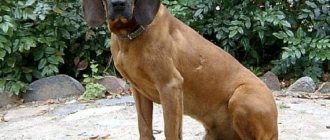What is color
Color is the visible pigment of the outer shell of the hair. If there is no coloring agent, the hair will be white. The concept of color includes not only color, but also its intensity, as well as fur pattern. It happens that several colors are mixed on the fur of one animal. However, color is the color that predominates over others.
All colors known to the world are divided into two large groups. The first includes single-color suits. The second consists of multicolored ones and includes animals whose fur coat contains two or more colors.
Color is the visible pigment of the outer shell of the hair.
The standard of every modern breed includes a mandatory coat color and type. Often the color of an animal is also used to identify the breed if the dog’s identity is unknown.
In nature, there are three pigments that color dog hair - yellow, brown and black. But the human eye perceives much more shades, thanks to the sensitivity of the retina and the refraction of light passing through the structure of the fur. So, you can distinguish intense brown from sand and gray from light black.
Dogs with a single-color coat in veterinary documents receive a laconic name corresponding to the color. If we are talking about an outbred animal, its color most often consists of several shades, therefore it is classified as complex and consists of the listed shades.
Dogs with two faces
What colors do dogs distinguish?
Dogs can see shades of yellow, blue and brown, as well as various shades of grey, black and white. This means that if your dog has a red toy, it will appear brown to him, but an orange toy, which is a mixture of red and yellow, will appear brownish-yellow. This also means that if you want to fully engage your dog's senses while playing, you should choose toys that are blue or yellow so that they stand out against the duller shades of brown and gray in your dog's field of vision. This explains why animals love bright yellow tennis balls.
From a genetic point of view
Breeders have long determined how the color and pattern on the fur of animals is formed. It's all about genes, among which there are those responsible for the color and structure of the coat. By mixing in various combinations, genes form color.
Genetics of colors
Coloring genes:
- Gen S. The most important component of the genetic chain. Thanks to this gene, the body is able to synthesize all “wool” colors. “C” itself is colorless. Its absence in the body is a sure path to albinism. However, even without this gene, the body is able to color the nose and iris. For some breeds, the C gene is a sign of a “purebred” color. These are Spitz dogs, white bull terriers and some types of huskies.
- Gen A. Distributes color throughout the hair. It can provoke a solid color, decorate the animal in “sable” or “agouti” tones.
- Gen V. “Black” gene, which colors the fur in dark colors. For the Giant Schnauzer and Newfoundland - a must. Other breeds may receive inclusions of the B gene in the form of tan marks or zonal coloring.
- Gene D. Responsible for the saturation of black color. When weakened, the gene lightens the coat and gives it blue tints. This also affects the viability of the animal. A Toy Terrier or Doberman born with recessive D develops a blue coat, but rarely lives to an advanced age. When dominant, the gene colors the pet deeply dark and promotes the development of the correct form of melanocytes - pigmenting cells.
- Gene E. Harmoniously distributes yellow, brown and black colors. Can “create” a tri-colored dog or a single color, eliminating unnecessary shades.
- Gene G. It can be called the “gray” gene, since it begins to lighten the hairs as the animal ages. Often a dog is born with a blue color and gradually changes the shade of its coat.
- Gen M. Marble color. In addition to the spotted harlequin pattern, the M gene in a homozygous state leads to congenital anomalies of the fetus. “M” is often classified as a modified color, since the basic tone may become lighter with age.
Main color genes
In addition to the genes described, there are other components of colors. Experienced breeders can read a puppy's genetic formula and determine its future appearance.
For example, ABCDEgmStr is a pet with black fur:
- the first letter “A” indicates a continuous distribution of color throughout the hair;
- the second - B - indicates the presence of black pigment;
- C indicates complete coloring;
- D indicates increased color;
- E - black color distributed throughout the body;
- g—the color will not fade with age;
- m - the color will not be arklequin;
- S - there will be no white points on the fur;
- the penultimate two letters indicate the absence of specks or roan color;
- the last icon is w - white color will not predominate.
Video - Genetics of dog color
Colors of dogs Elise 08.11.11, 20:34
The color of a dog's coat is called suit. The colors of dogs are very diverse. Dog coat color can be one-color, two-color or multi-color. If the color is one color, then the documents for the dog simply indicate: white, black, red. In outbred dogs, in veterinary certificates the black and white coloring is sometimes designated as “speckled”. If the coat has different colors, then it is called complex, and in this case the so-called color is indicated. Colors - This is a pattern formed by different colors of wool. These can be tan marks, white-legged, shabby, stripes, etc. Dogs of the same color often have white (pigment-free) spots on the chest, neck, paws, muzzle, tail, etc. Accurate determination of color is important for the correct preparation of documents for dogs (list composition, accounting or pedigree records, etc.). Main types of suits
Harlequin. Small black spots with uneven, as if torn edges on a pure white background. The same color is called marbled.
White suit. The coat is without pigment. Pigmented black or brown nose, eyelids, edges of lips and colored irises. Pure albinos are not found among dogs.
Fawn color. Sandy, reminiscent of a weakened redhead. Varying in shades. Dogs of this color have almost white legs, chest and lower tail. The mask is most often dark, sometimes even black.
Black color. There is no absolutely black color; most often it comes with white spots, sometimes very insignificant. There are also brown, brown and gray markings.
Brown color. Diverse in shades - from pure brown to brown (brown with black).
Red color. Very varied in shades. It can be red-red, bright red with darker hair on the head, neck, back, upper side of the tail, bright red with lighter hair on the throat of the chest, sides and limbs; light red (sometimes called yellow).
Golden-red color. Usually - with a reddish tint at the end of the hair, uniform throughout the body. More often found in combination with a dark, sometimes even black muzzle - a mask.
Black color. Two-color. The main color is red of any shade (from light fawn to bright red) and a gray or black saddle blanket that seems to cover the dog on top. Starting from the head, black hair covers the bridge of the nose, forehead, neck, ears, back, shoulders, hips and the top of the tail. The lower jaw and underside of the head, cheekbones, larynx, chest, belly, legs and underside of the tail may be light in color. The saddle cloth varies in size and color tone. It can start from the neck, while the head remains light. Sometimes the saddle cloth covers only the upper part of the shoulders and hips or goes all the way down to the legs. The saddle cloth can be gray, black, brown, with sharp outlines of the border between dark and light hair, or gradually merging with the background. The saddle color finally appears after the puppy's hair changes. Black and tan puppies are usually black and tan. As they age, the fur on their heads, limbs and sides becomes lighter.
Tan color. The main tone can be different - black, brown, gray. Tan marks are light marks compared to the main color and have a constant pattern. The tan marks are sharply demarcated from the main color and are located in the form of two spots: above the eyes (eyebrows), on the muzzle (except for the back of the nose), on the chest (two triangular spots with their apices facing each other), as well as on the cheekbones and larynx. Tan marks may cover the front legs to the pasterns and the hind legs from the front to the hocks, as well as the inside of all legs, forming spots around the anus and on the underside at the root of the tail.
Zonar gray or wolf color. The hair has a characteristic, light, devoid of pigmentation band, dividing it into several sections (zones). The hair of a zone-gray dog is characterized by a light coloring of the base. Color zones are located on the hair of a zone-gray dog as follows: black, light, yellow; the end of the hair is black or light. Light gray puppies have a dark stripe (strap) along their backs; Permanent color in zone-gray dogs appears only after the puppy coat has changed. In addition to zone-gray, there is also a zone-red color. If a zone gray dog has brown and black shades of hair, it is called brown.
Tiger color. The color resembles that of a tiger's coat (hence the name). Dark transverse stripes are located on a yellow, brown, fawn or gray background. These stripes are sometimes called brindle stripes.
The correct brindle color has a golden or light brown background, on which there are bright, intensely colored rings that disappear in the groin area and connect on the back and chest. In greyhounds, the brindle color is called forelock. Most brindle dogs have a dark mask. Deviations are considered to be a dim background and weak brindles that do not close in rings. In brindle coats, white markings are allowed.
Roan color. In this color, white hairs are evenly interspersed between the individual colored hairs, creating a characteristic silvery-attenuated color.
Solid color. With this type of color, the dog does not have white, depigmented areas of fur. Only a lighter or darker tone of the main color is possible, more often in certain places (ears, muzzle, paws, tail, etc.). The presence and location of these shades are indicated in the breed standard.
White mask. (Reverse mask). Sharply lightened color of the muzzle with clear boundaries of the pattern against the background of the darker overall color of the dog. Often found with zoned-gray, “wolf” color. The white mask may be accompanied by the same white “glasses”. Characteristic of some breeds of huskies.
Marble color. A color in which small black or brown-gray spots with torn edges are evenly scattered on a white, gray-blue or other light background.
Murugy color. Dark red to mahogany color, with black or dark tips of the guard hairs. Deer color. Yellowish-brown-red, with dark or reddish-brown ends of the hair on the nape and back. The ears are darker in color than the main color. Piebald color. Two-color color, formed by large white, often merging spots (pezhins) on the main - red or any other - background. Pezhins come in the form of blazes from the nose to the forehead or back of the head, collar, white chest or belly, tips of the paws (socks) or tail. Pepper and salt. A color in which light and dark zones alternate in each hair of the outer hair. Depending on the predominance of certain zones, shades of this color are formed - from silver-gray to dark steel. Liver color. Dark, reddish brown. Spotted color. White, with dark spots (black, red, gray), usually located near the eyes, on the ears, on the body and at the root of the tail. Source: Dog Guide
complain
The influence of color on other characteristics
Any gene in a dog’s genotype is responsible not only for the characteristics of the coat, but also for other indicators. Thus, color can be confidently associated with other characteristics of the breed. Breeders have identified a pattern between coat color and animal behavior.
Black and dark brown
Dogs with a black or brown-black color have a rather obstinate disposition. Such pets crave dominance and need strict training. At every opportunity, they try on the role of authority “in the pack.”
At the same time, the behavior of black dogs is restrained. The animal is confident in itself and does not need to demonstrate its strength ostentatiously. Responsible guards and brave comrades. They are independent and easily tolerate loneliness.
Dogs with black coats crave dominance and need rigorous training.
Among the popular breeds with black hair, it is worth noting the following:
- Yorkshire Terrier.
- Rottweiler.
- Schipperke.
- Polish hound.
- Manchester Terrier.
- Bernese Mountain Dog.
- Moody.
- Bouvier des Flanders.
- Doberman.
- Curly coated retriever.
- Smoland Hound.
- Tibetan mastiff.
Red wool
Fire dogs are quite inventive. Their temperament is dominated by cunning. Unlike their black counterparts, redheads achieve their goals on the sly, never openly entering into conflict.
The character of red dogs is dominated by cunning.
Light and flexible. However, they remain puppies all their lives. They often play dirty tricks and have fun, breaking the rules for fun. Red dogs are very loyal, but extremely emotional.
On a note! Very talkative. Red dogs prefer to vocalize everything they see. They often bark, howl and whine.
Popular breeds with red hair:
- Welsh Springer Spaniel.
- Red Coonhound.
- Irish Setter.
- Beagle.
- Jack Russell Terrier.
- Pomeranian Spitz.
Inheritance of colors
Brindle
Such animals contain the best qualities of red and black dogs. Open and social, but serious and responsible. Brindles make excellent guard dogs. It is important for the owner to get used to some slowness of the pet. Over time, phlegmatic behavior will cease to be an annoyance during training.
Rare breeds with brindle color:
- Kai-inu.
- German boxer.
- Tiger Akita.
- Amstaff.
Tiger Akita
Whites and albinos
A very peculiar disposition conceals a colorless color. White dogs are extremely capricious and vain. They carry out commands, serve and accompany. However, they always strive to bask in fame and adoration.
Somewhat stubborn and disobedient. The difficulty of training lies in the animal's reluctance to be trained. The stubborn nature does not interfere with decorative breeds, but brings difficulties to service breeds. Despite the difficulties, light and white puppies are the first to be sold out.
Popular white breeds:
- American Spitz.
- Akbash.
- English bulldog.
- Bichon Frize.
- Bolognese.
- Volpino Italiano.
- Bolonka.
- Commander.
- Samoyed dog.
- Poodle.
- Kuvasz.
- American Shepherd.
- Kisu.
- Bullets.
A peculiar disposition conceals a colorless color
Dark wool
These important and obstinate individuals strive to dominate everywhere and in everything. In a pack, black dogs are strict and authoritative; by nature they are leaders. Dogs with dark coats are reserved, self-confident, responsible and brave. They can easily tolerate loneliness. They have a very tough character, distrustful of strangers, which requires proper training.
Representatives of black breeds are Rottweiler, Doberman, Tibetan Mastiff.
Character is determined by genes at the initial stage of an animal’s life, but in the future everything depends on how the owner raises the dog.
How to choose a puppy
To get a pet of a certain color, the owner must pay attention to the puppy's parents. The cub will definitely inherit the appearance of one or two ancestors, so it must be taken into account. For example, if a silver tint to the coat is undesirable, then it is better not to buy a puppy from such a parent. A dog's appearance can change with age. This is how modified colors manifest themselves.
Of course, his appearance is unlikely to affect his love for his pet. However, it is important to choose the color carefully if the dog is to continue its purebred lineage.
The puppy's coat color depends on the coat color of the parents.
In order not to make a mistake with the choice, breeders have drawn up several rules to help “predict” the future appearance of the pet:
| Puppy appearance | Forecast for the future |
| The cub has a hard coat structure | An adult dog will have short hair |
| Fur fluffed up like cotton wool | In the future - unclear color lines, dull fur, lack of shine |
| Subtle waves in the hair structure | Over time, a pale silver teak will appear |
| Silky "plumage" | The puppy will have a uniform color and correct fur structure |
Cause of color blindness
By the way, many people also cannot distinguish between all colors. 6 boys and men out of 100 do not distinguish the color green. Women almost never have such problems. Color vision problems are passed on to offspring with the same genes that make boys boys. The cause of color vision impairment may be due to damage to the retina, the thin layer of cells that lines the inside of the eyeball.
Structure of the eye
Some of these cells are called cones; they perceive the color of light falling on the retina and send information about this to the brain. Cones contain pigments, chemicals that absorb light of different wavelengths, that is, different colors.
In humans, cone pigments are sensitive to the three primary colors: red, green and blue. Light is absorbed, impulses are excited in the cones, which are transmitted to the brain along the optic nerve. Somehow the brain deciphers this information, and we perceive the world in multicolored colors. Some patients suffering from impaired color discrimination see only yellow or blue; everything else is perceived in gray, black and white. Some people distinguish between red and green well, but do not see yellow and blue; others, fortunately there are few of them, see the world in shades of black, white and gray.
In most cases, impairment in color discrimination is a congenital disease and is inherited. But there are cases of color vision impairment caused by disease of the optic nerve or damage to the areas of the brain responsible for vision.
Interesting: Interesting facts about dogs: description, photos and videos
Dogs do not have red-sensitive cones. Therefore, they do not perceive the difference between yellow-green and orange-red colors - it is similar to how colorblind people see. And what you and I perceive as blue-green may appear white to a dog. But these animals distinguish shades of gray much better than humans. And it’s not just that there are more rods in the retina of a dog’s eye - light-sensitive cells responsible for vision in the twilight. Most likely, their rods themselves are more sensitive than those of humans. This is why dogs have good night vision.
Interesting fact: dogs do not distinguish green from red and confuse both of these colors with yellow or orange.
Jacobe says no one knows exactly what a dog sees when it perceives color. A dog's cones are sensitive only to the colors red and blue, so an orange, a banana, and an apple all look the same red to a dog. The only thing we can say is that the dog’s world is much more picturesque than we imagined.
